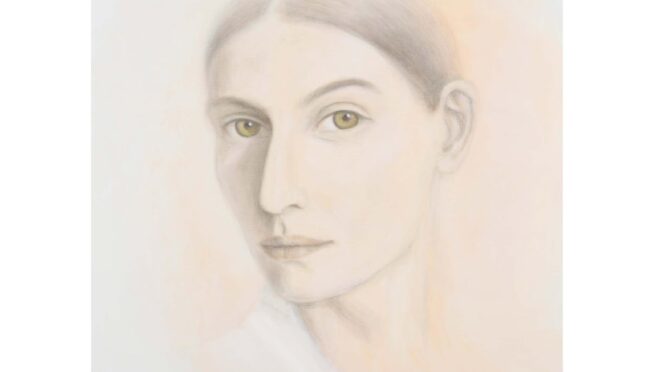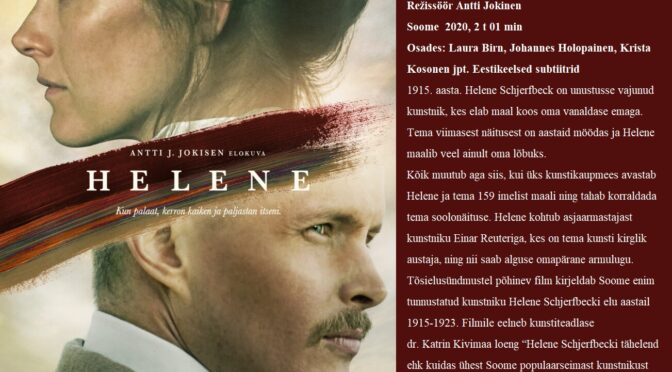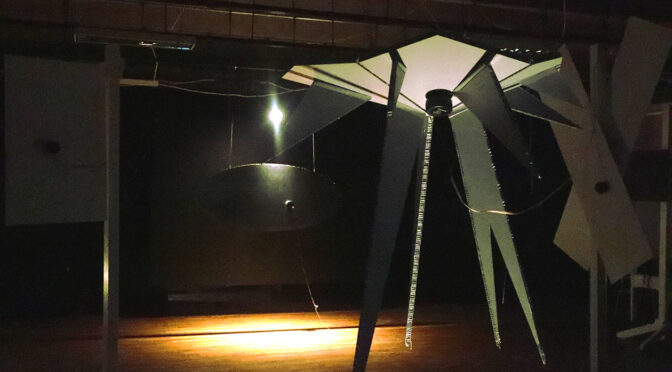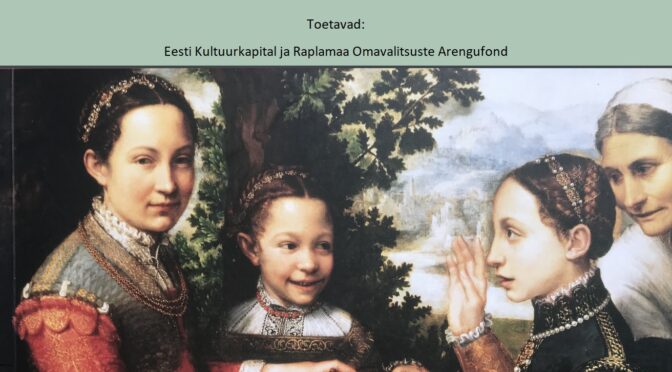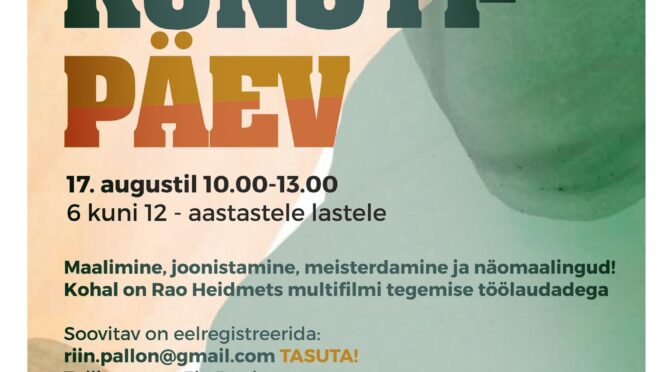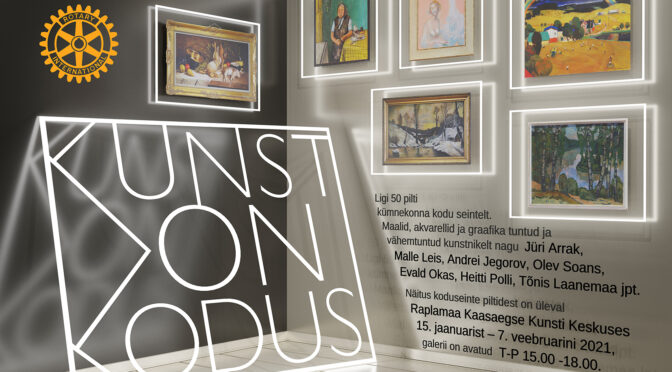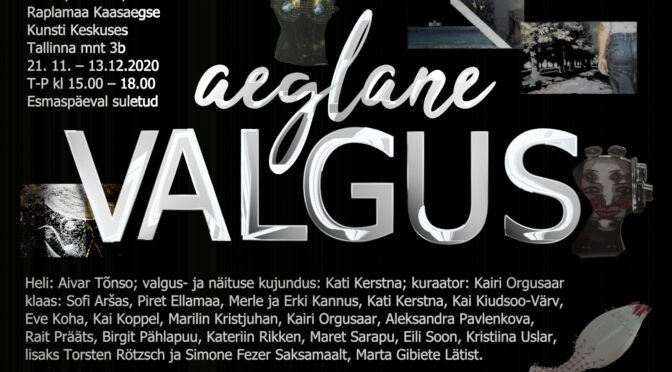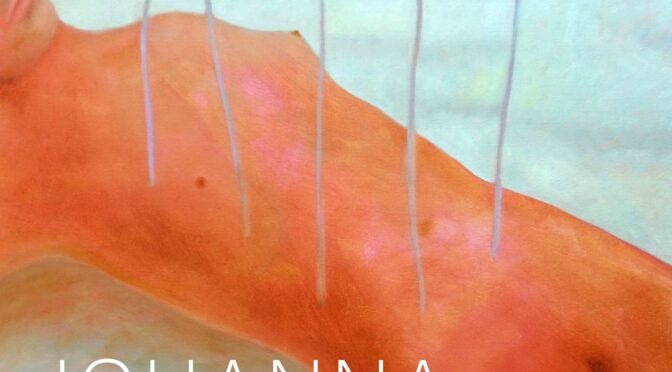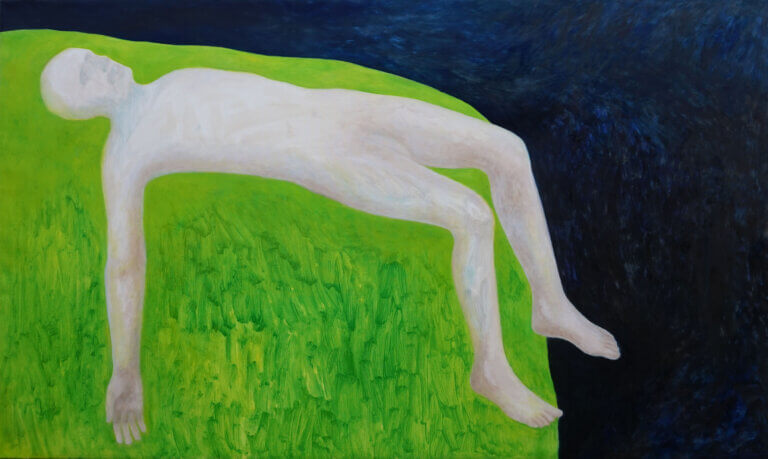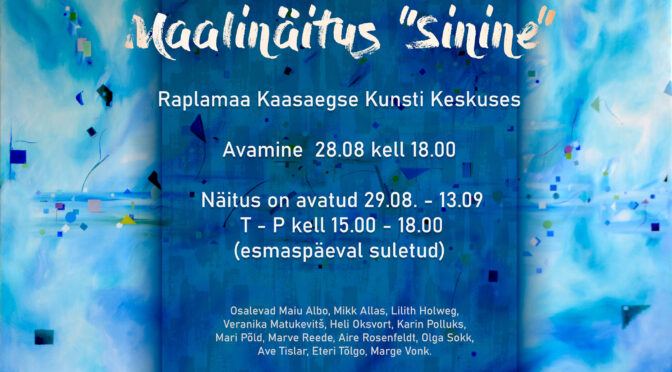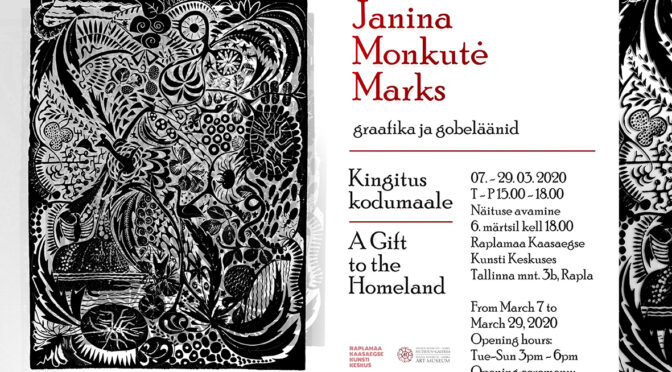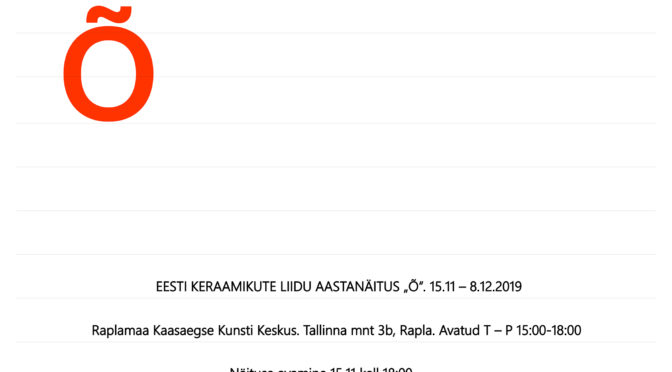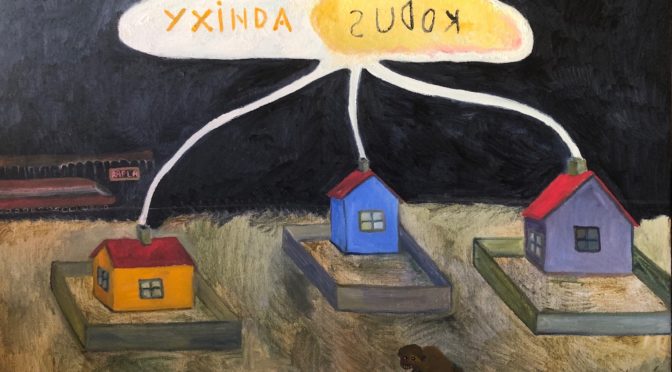Category Archives: Events
Lecture and film “Helene”
Mar 13 at 14.00
Aivar Tõnso – artist talk
Dec 18 at 16.00
Lecture by Anne Untera: Baltic German female artists
Nov 3 at 18.00
Kids’ Art Day
August 17, 10.00-13.00
Art Is Home
Some 50 artworks from the homes of Rotary Club members have found their way into this exhibition: paintings, watercolours and prints by authors such as Jüri Arrak, Malle Leis, Andrei Jegorov, Olev Soans, Evald Okas, Heitti Polli, Tõnis Laanemaa. In the words of club member Ruve Schank, the Rapla Rotary club calls for a deeper appreciation of art, including art that has found its way into homes. A good artwork can often give us energy for the day, or help us alleviate daily stress.
Art may have its purposes within itself, or express a political standpoint, but in a domestic setting, we look for the kind of art which brings pleasure – and so, the current collection is mostly made up of landscapes, still lives and nudes, plus some portraits, and prints by Soans and Kaljo Põllu.
Curator and exhibition designer: Valter Uusberg.
Graphic design: Kati Kerstna.
Slow Light
The Rapla County Centre for Contemporary Art presents:
SLOW LIGHT
An exhibition of glass & light objects
with spatial sound and moving lighting design
https://kultuur.err.ee/1162396/raplamaa-kaasaegse-kunsti-keskuses-uuritakse-klaasikunstnike-uudisloomingut
https://www.ohtuleht.ee/1018451/galerii-raplas-avati-klaasist-valgusobjektide-naitus?fbclid=IwAR0XHHCV9WDpTAtVsWEDJS-IHSDSdiq2YH73QAUMKG5QZfutmA-Ey1vVYKU
Light travels slowly on the Disc and is slightly heavy, with a tendency to pile up against high mountain ranges. Research wizards have speculated that there is another, much speedier type of light which allows the slower light to
be seen, but since this moves too fast to see they have been unable to find a use for it.
When light encounters a strong magical field it loses all sense of urgency. It slows right down. And on the
Discworld the magic was embarrassingly strong, which meant that the soft yellow light of dawn flowed over the sleeping landscape like the caress of a gentle lover or, as some would have it, like golden syrup.
Light thinks it travels faster than anything but it is wrong. No matter how fast light travels it finds the darkness has always got there first, and is waiting for it.
Terry Pratchett
The Rapla County Centre for Contemporary Art finalises its 10th anniversary programme with an international exhibition of glass & light objects titled Slow Light. A “living” display where luminous objects move in the dark space, casting shadows, reflections and surreal images. Others stay still, with only a pulsating inner luminescence revealing their hidden facets. Light and sound connect the pieces into a unified, abstract spectacle, where every work plays a role.
The exhibition offers an exciting gamut of ideas and techniques. Participating artists – celebrated internationally and locally – each have developed a unique vision and handwriting.
The year 2020, with its unexpected developments, has made us contemplate our environment and humanity from new angles. The works, most of which were created specially for the occasion, display both humour and wistfulness, but also deeper perceptions and reflections.
Participants:
Sofi Aršas, Piret Ellamaa, Merle Kannus, Erki Kannus, Kati Kerstna, Kai Kiudsoo-Värv , Eve Koha, Kai Koppel, Marilin Kristjuhan, Kairi Orgusaar, Aleksandra Pavlenkova, Rait Prääts, Birgit Pählapuu, Kateriin Rikken, Maret Sarapu, Eili Soon , Aivar Tõnso, Kristiina Uslar (Estonia), Torsten Rötzsch, Simone Fezer (Germany), Marta Gibiete (Latvia).
Curator: Kairi Orgusaar.
Exhibition, lighting and graphic design: Kati Kerstna.
Sound composition: Aivar Tõnso.
Opening Nov. 20.at18.00
The Rapla County Centre for Contemporary Art, Tallinna mnt. 3b, Rapla.
Open Nov. 21– Dec. 13, Tue-Sun 15.00 – 18.00.
Closed on Mondays.
Sponsored by:
Cultural Endowment of Estonia, CEE Rapla County expert group, Rapla Parish, Rapla County Municipalities’ Development Foundation.
TIMETRAVELLER
Johanna Mudist
Timetraveller
16.10-01.11.2020
The main focus of the paintings is the human and the nature surrounding it. The third important component, besides the body and the place, is time. Benjamin Franklin has said „Do not squander time, for that is the stuff life is made out of.“
In my work I do not deal with the agreed-upon time, but rather with psychological time, which we perceive when we experience waiting. When waiting, the perception of time changes, it broadens – it is a condition where the body is in the present, but the thought has already travelled elsewhere, to the potential future. This state is externally static, but internally anxiously intense. In my paintings, time is an element in which people are seemingly stuck, it is something that isolates and incarcerates.
In the paintings, the characters let the experience of silence, time and place sacrally run through themselves. Some figures are passively waiting for the tides or the wind, others have embarked on a quiet journey to find the way to a better past of future. They are wandering in a bit dreamlike, impossible situations and places. The paintings describe the destination of the the journey or the journey itself
BLUE
You are welcome to the opening of the painting exhibition “Blue“ in Rapla County Centre for Contemporary Art 28.08.2020 at 18.00.
Participating Maiu Albo, Mikk Allas, Lilith Holweg, Veranika Matukevitš, Heli Oksvort, Karin Polluks, Mari Põld, Marve Reede, Aire Rosenfeldt, Olga Sokk, Ave Tislar, Eteri Tõlgo, Marge Vonk.
This year’s theme of the exhibition is inspired by the color blue, which has also been considered a carrier of truth, contemplation and serenity. Every student interested in art has approached the topic from their own angle, giving the shade and nuances of the blue tone.
Some of the participants in the exhibition are already experienced artists, for whom it is already in several exhibitions, while others are just starting their first works.
The exhibition will be open 29.08-13.09.2020, Tue-Fri at 15.00-18.00 in Rapla County Centre for Contemporary Art (closed on Monday).
A Gift for the Homeland
JANINA MONKUTĖ – MARKS
(1923 – 2010)
A Gift for the Homeland
The Rapla County Centre for Contemporary Art is pleased to announce the opening of renowned Lithuanian-American artist Janina Monkutė-Marks on our premises on April… 2020. The exhibition became a reality thanks to the Janina Monkutė-Marks Museum in Kėdainiai, Lithuania.
Janina Monkutė-Marks was born in Radviliškis, Lithuania, Sept. 21, 1923; her father worked as a railwayman. Escaping Lithuania in 1944, she studiet at the Innsbruck University, Austria, and at École des Arts et Métiers, Freiburg, Germany, with a number of Lithuanian emigrants as professors – Antanas & Anastazija Tamošaitis, Vytautas Kasiulis, Vytautas Kazimieras Jonynas, Viktoras Petravičius.
In 1950 Janina resettled in the USA. Since 1956, she actively participated in the Chicago art scene, and was connected to the Hyde Park Art Center (Chicago) and the B.I.G. Arts Center (Sanibel, Florida). Her works have been exhibited by the Chicago Art Institute, The North Shore Art League (Winnetka, Illinois), Dunes Art Foundation (Michigan City, Indiana), Sun Times Gallery (Chicago, Illinois), Old Water Tower Place (Chicago, Illinois) et al; she had more than 20 individual exhibitions. She also participated in the events of Lihuaninan culture & art organizations, e.g. the Balzekase Museum of Lithuanian Culture, the Čiurlionise Gallery and the Museum of Lithuanian Art in Lemont.
Her early paintings and prints were influenced by the so-called Chicago Imagists (Leon Golub, Seymour Rossofsky et al), who stood in opposition to the 1950s mainstream of Abstract Expressionism, but also later opposed Pop Art, considering the primary task of art to be the expression of the artist’s personal experiences and emotions.
Between 1962-1966, Monkutė-Marks created a series of works utilizing the imagery of Pop Art; she later returned to her Lithuanian roots, finding inspiration in folk art motifs. The artist had a sizable collection of folk art from across the globe.
Since the 1970s, textile was Monkutė-Marks’s preferred medium of expression.
In 2000, the artist donated a major part of her creations to her native Lithuania, founding her museum in Kėdainiai, which opened its doors in 2001.
Janina Monkutė-Marks died in Chicago, Nov 13, 2010.
At the current exhibition in Rapla, we bring you a selection of Janina Monkutė-Marks’i linoleum block prints and tapestries.
The motif of road and journey is one of the most significant in the art of Janina Monkutė-Marks. Journey is interpreted as a quest for the meaning of life and soul-searching in the tapestries “Man and His World,” “Longing for Freedom,” “Going Home,” and “My Road.” Existential meaning is imposed even on the tapestries based upon “real” travel, such as “Going to the Wedding” and “Left Behind.” Janina Monkutė-Marks often portrays the feeling of “being on the road” as a labyrinth; one that has no beginning or end, no strictly positive or negative zones. It is as though the artist suggests that there is no chance to predict an upcoming turn of the road or escape the labyrinth. It is only possible to experience it fully.
Some of the artist’s linoleum block prints imitate the compositional scheme of traditional folk art (“My Road”, “Angel”); elsewhere, she combines the rough shaping of individual forms with geometric ornaments – these are substantial and generalized, represented not only by a contour line but also by entire silhouette. The artist fully employs the deep contrast and intensity characteristic of linoleum block printing. Floral and anthropomorphic allusions, geometric abstractions, traditional ornaments and the artist’s original motifs merge into a mysterious, magical world.
Janina Monkutė-Marks’s works are characterized by clarity of shape and exceptional compositional stability, intensity of colour and variability of texture. The subjective point of view and the courage to open up her inner world are not only recurrent but also some of the most valuable features of Janina Marks’s art, where the ironic and the tragic, the religious and the liberal, primitive and modern are elegantly combined.
Estonian Ceramists Associaton´s annual exhibition Õ
Õ is a letter unique to the Estonian alphabet. This exhibition celebrates the uniqueness of Estonian culture.
Participants:
Mare Vichmann, Haidi Ratas, Kersti Karu, Maia Noorväli, Kärt Seppel, Kattri Takklaja, Kersti Laanmaa, Eliisa Ehin, Anne Türn, Kadi Hektor, Merike Hallik, Reeli Haamer, Rave Puhm, Helena Tuudelepp, Georg Bogatkin, Eva Berg, Kadri Jäätma, Ann Nurga, Karin Kalman, Külli Kõiv, Urmas Puhkan, Anu Rank – Soans, Rita Randmaa, Pille Kaleviste, Ene Tapfer, Üllo Karro, Tiina Kaljuste, Aigi Orav, Margit Mald, Margit Terasmees, Henriette Nuusberg – Tugi, Marget Tafel – Vahtra, Leena Kuutma, Jarõna Ilo
Designer: Üla Koppel
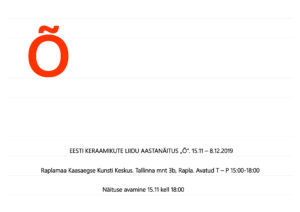 Open 15.11 – 08.12.2019, T – P 15.00 – 18.00
Open 15.11 – 08.12.2019, T – P 15.00 – 18.00
Small Town as an Identity
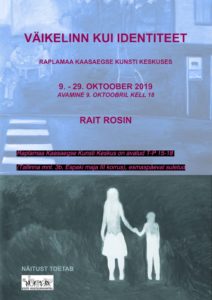 The topic of this exhibition is the creation of identity as part of shaping the social organisation and quality of life in small towns, and the role that art plays in small town life.
The topic of this exhibition is the creation of identity as part of shaping the social organisation and quality of life in small towns, and the role that art plays in small town life.
Artists usually represent their own ideas and preferences in their exhibitions, while the surrounding settlement forms a dense network of connections, presenting the viewer with meanings and visual identity specific to the location. Residents’ opinions about art events reflect the daily life in the town, while expectations toward artists work towards shaping local identity.
The artist conducted interviews with artists who’ve had their solo exhibitions at the RCCCA and the Rakvere Gallery, videos of which are on display at the exhibition. There are also audio interviews with exhibition visitors. It is notable that, while artists see their work in a wider context, and tend to compare it with metropolitan events, the expectations of the audience retain local connections. Art is seen as a colourful distraction from topics that have real consequences for the lives of residents.
The artist also conducted a performance where he dragged a wheeled box representing future Rail Baltic through the streets of Rapla.
The exhibition is part of the author’s doctoral thesis – more info at www.pragmatist.ee
